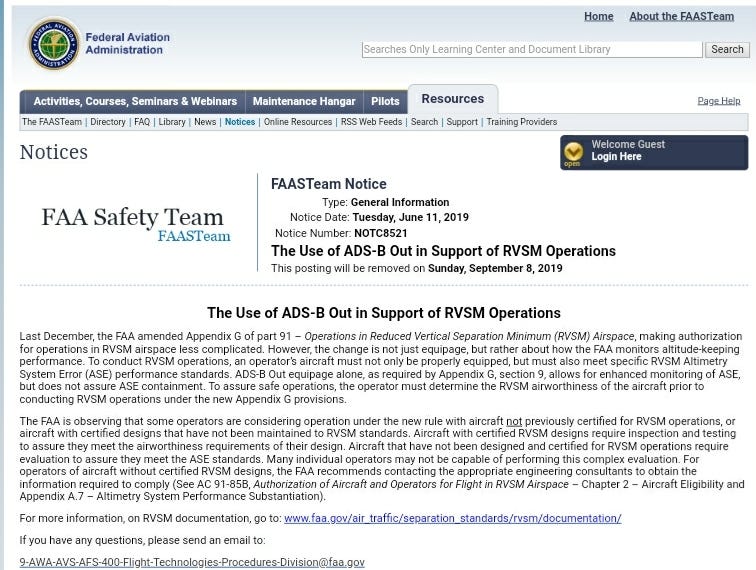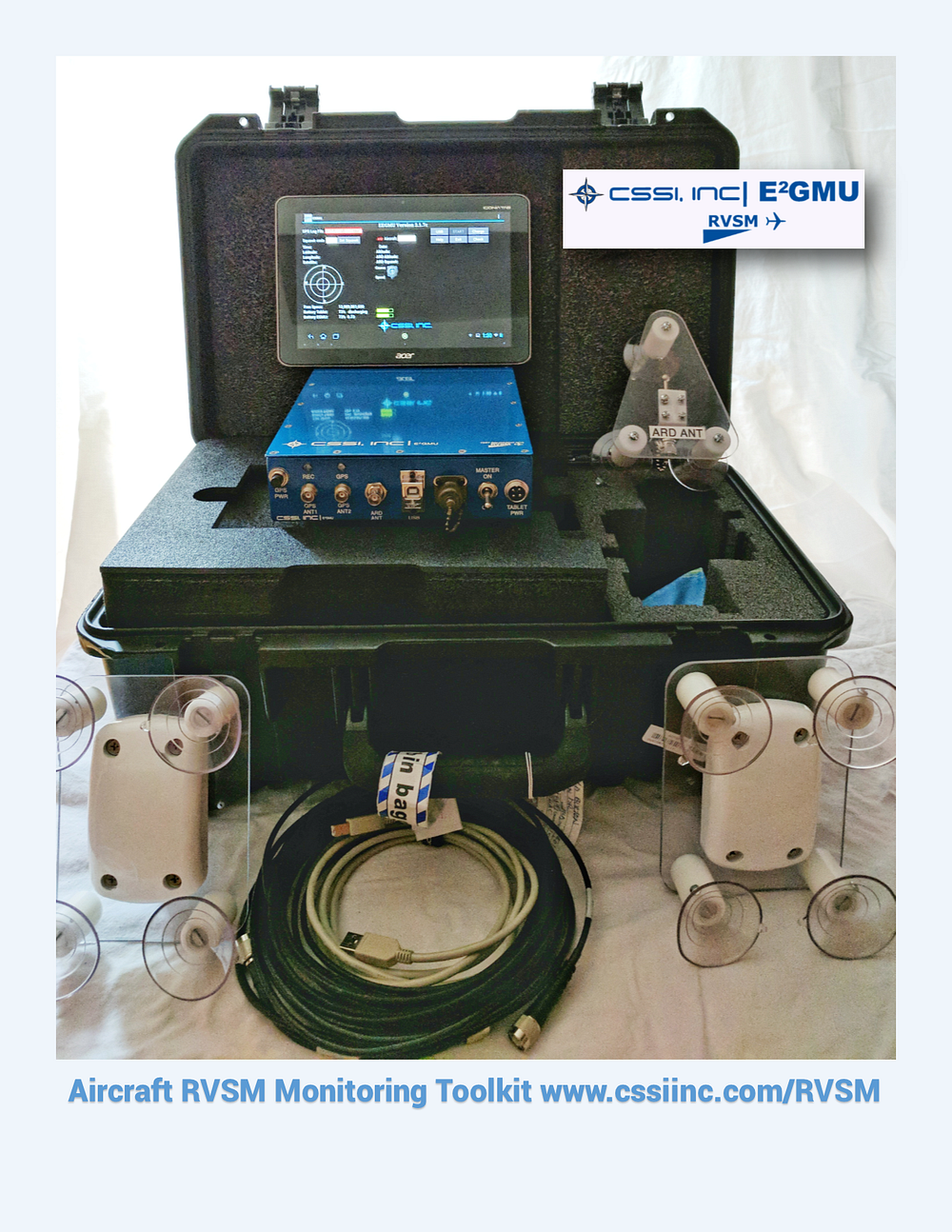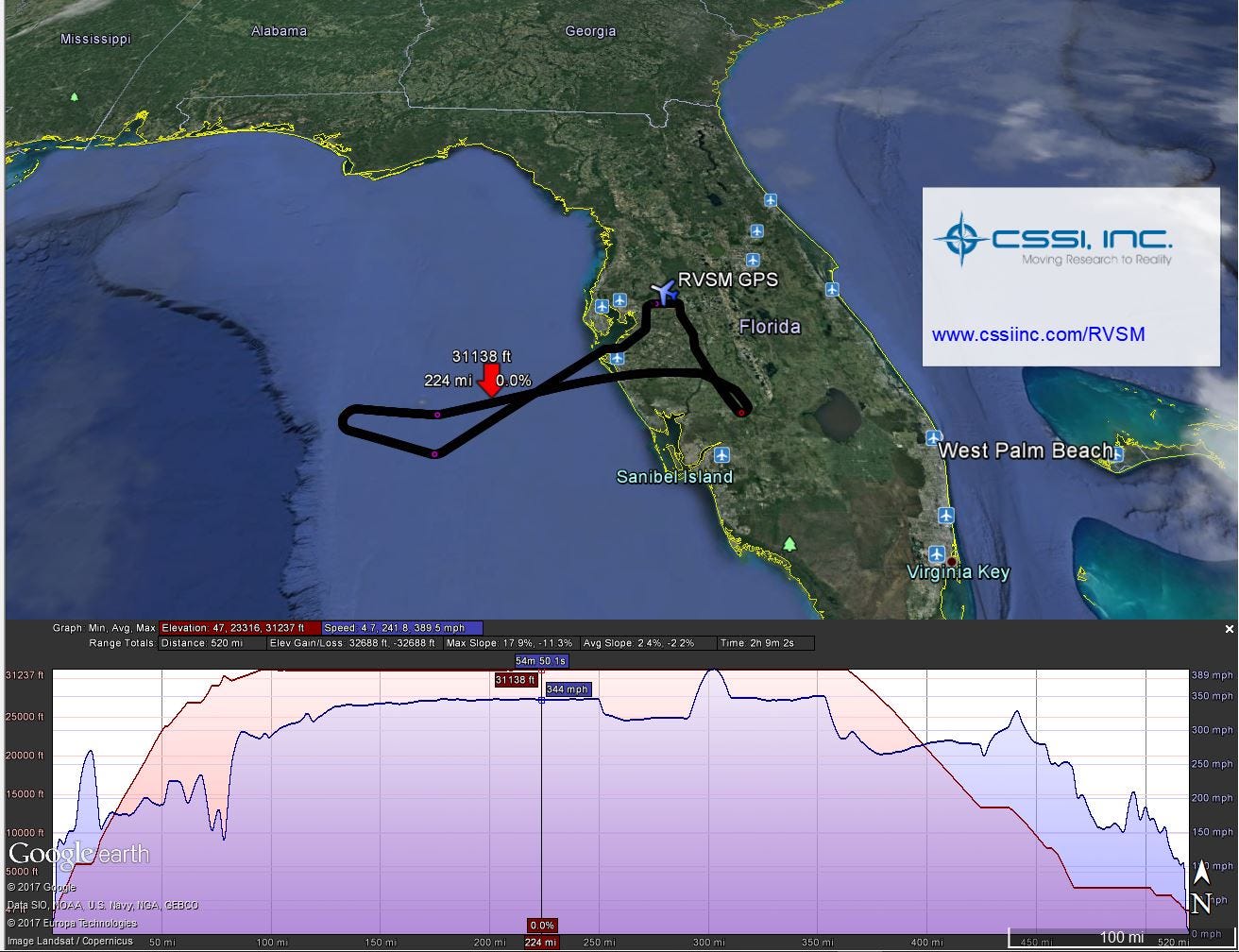What Does Rvsm Stand for in Aviation
RVSM Monitoring Frequently Asked Questions
![]()

Here are some answers to the most frequently asked questions about RVSM (Reduced Vertical Separation Minima) and Monitoring.
What is RVSM Monitoring?

RVSM Monitoring is the method to confirm height- keeping performance of aircraft f o r Air Traffic Control (ATC) to maintain safety in reduced vertical separation. The actual altitude (not the pressure altitude flown) is not observable by both the pilots and ATC so the RVSM Monitoring test samples the aircraft performance using GPS height and altitude and compares it with the pressure altitude flown. If the aircraft performs with in the safety tolerance for altitude vertical error, the aircraft is considered RVSM Approved.

RVSM Monitoring supports the safety assessment and safety oversight function that is required with implementation of RVSM Airspace. Aircraft operators wishing to utilize the RVSM Airspace must comply with the safety requirements required for reduced vertical separation minima and pass height keeping performance safety checks. See FAA Advisory Circular 91–85 linked below for more information.
Is RVSM Monitoring required?
Yes, an operator must meet the minimum monitoring requirements established by its State Authority to maintain their RVSM Approval Status.
What do the Long Term Monitoring Requirements mean to my operations?
In order to maintain RVSM approval status, all aircraft approved for RVSM operations must complete an RVSM monitoring flight every two (2) years or 1,000 flight hours (whichever period is longer).
When should I get my aircraft monitored for RVSM?
Operators that have been issued an US RVSM authorization will be required to conduct initial monitoring within six (6)months of date of issue and must conduct monitoring every two (2) years or 1,000 flight hours per aircraft, whichever period is longer.
What are my options for performing an RVSM Monitoring test for my aircraft?
Aircraft can be monitored for RVSM by overflying a ground-based monitoring station (such as the US AGHME) or flying an RVSM profile with portable test equipment onboard, such as an E2GMU. Aircraft not equipped with a Mode S transponder must complete an E2GMU monitoring flight.
My aircraft is equipped with ADS-B Out, do I still need to perform an RVSM Monitoring Flight test?
FAA information on ADS-B
The answer for North America is yes, after you have ADS-B installed in your aircraft, you currently still need to perform a separate RVSM Monitoring flight test to remain in compliance. You must perform the test if your aircraft is at either 1,000 flight hours since the last RVSM Monitoring test or it has been 2 years since the last RVSM Monitoring flight test (whichever period is longer). This RVSM Monitoring requirement is expected to change after January 2020 to RVSM Monitoring required every 2 years (removing the 1,000 flight hours option) and this article will be updated when more is known.

You must also satisfy the RVSM monitoring requirement by some other method (method other than ADS-B Out — AGHME ground station overflight or E2GMU test flight) in the 24 months prior to installation of the ADS-B Out system.
Before you equip ADS-B Out, make sure you are current with the RVSM Monitoring flight test in the past 24 months prior to the installation.
Yes, after you have ADS-B installed in your aircraft, you currently still need to perform a separate RVSM Monitoring flight test to remain in compliance.
Currently the North American Approvals Registry and Monitoring Organization (NAARMO) and US Federal Aviation Administration have completed the process for testing ADS-B Version 2 equipped aircraft for RVSM Monitoring with ADS-B Out in the entire US National Airspace System.
No Pre-Planning is required for RVSM Monitoring flights with ADS-B Version 2 equipage — the ADS-B flight data is automatically recorded and processed for Altimetry System Error. You must, however, complete the ADS-B RVSM Monitoring request form for your aircraft data to be monitored http://www.faa.gov/air_traffic/separation_standards/naarmo/.
Any aircraft flying within US ADS-B Rule airspace is automatically monitored.
The NAARMO shares the Altimetry System Error flight test results of all aircraft that have been RVSM Monitored with ADS-B Version 2 with the world's Regional Monitoring Agencies on a monthly basis. The operator is encouraged to notify the foreign Aviation Bureau and Regional Monitoring Agency of aircraft registry to be informed of the ADS-B Version 2 monitoring flight in the USA and search for the aircraft result. The flight test results will not be automatically sent directly to the foreign Regional Monitoring Agency — the Regional Monitoring Agency will need to be informed by the operator.

The FAA has recently released a notice on the requirement for RVSM certification prior to operation:
The FAA is observing that some operators are considering operation under the new rule with aircraft not previously certified for RVSM operations, or aircraft with certified designs that have not been maintained to RVSM standards. Aircraft with certified RVSM designs require inspection and testing to assure they meet the airworthiness requirements of their design. Aircraft that have not been designed and certified for RVSM operations require evaluation to assure they meet the ASE standards. Many individual operators may not be capable of performing this complex evaluation. For operators of aircraft without certified RVSM designs, the FAA recommends contacting the appropriate engineering consultants to obtain the information required to comply (See AC 91–85B, Authorization of Aircraft and Operators for Flight in RVSM Airspace — Chapter 2 — Aircraft Eligibility and Appendix A.7 — Altimetry System Performance Substantiation).
For more information, on RVSM documentation, go to: www.faa.gov/air_traffic/separation_standards/rvsm/documentation/

U.S. registered operators whose altitude-keeping performance has been evaluated using data collected through ADS-B Out may obtain monitoring performance here: http://www.faa.gov/air_traffic/separation_standards/naarmo/.
For service, operators beginning operations under the provisions of appendix G section 9 should notify the North American Approvals Registry and Monitoring Organization (NAARMO) of their initial flight details by completing the email template on the NAARMO website above.
In other countries (such as Australia) ADS-B Out is already used for RVSM Monitoring testing. We expect North America to follow and offer this capability soon before the 2020 implementation deadline.
My aircraft is not registered in the USA, can my aircraft be monitored with ADS-B inside the USA?
Yes, foreign operators with aircraft registered in other countries can be monitored for RVSM in the USA but they must request the monitoring service as the RVSM flight test will not be automatically recognized. Operators may request by completing a form on this page and emailing the request to the NAARMO. Download the ADS-B Height Monitoring Request Form (PDF)
The information for ADS-B monitoring and instructions are linked below.
Once the RVSM flight is completed inside the continental USA where the terrestrial ADS-B service is in operation and the ADS-B monitoring request is submitted to the NAARMO, the results of the test may take up to 4 weeks.
Please also note that the NAARMO will not post the results of the RVSM monitoring test of foreign aircraft to the website.
The Operator will need to contact their State Authority of aircraft registry to obtain the results.
The State Authority of registry will contact the applicable Regional Monitoring Agency for their state. The Regional Monitoring Agency will be able to find the aircraft test results that the NAARMO has shared once the ADS-B Monitoring data results are completed.
When the Regional Monitoring Agency finds the ADS-B RVSM Monitoring test results from NAARMO, the Regional Monitoring Agency will send a formal letter to the State Authority verifying the RVSM monitoring results are completed.
Here is an example of the process:
- A Brazilian Operator would like to be monitored in the USA with ADS-B, the Brazilian Operator contacts the NAARMO using the request form and flies RVSM in the continental USA airspace.
- After 4 weeks, the Brazilian Operator contacts the Brazilian ANAC to inquire about the ADS-B RVSM Monitoring flight in the USA with the date of flight and any other information.
- The Brazilian ANAC will contact the Regional Monitoring Agency CARSAMMA to request information on the ADS-B RVSM Monitoring flight.
- The CARSAMMA will consult the NAARMO ADS-B RVSM Monitoring records shared between Regional Monitoring Agencies. If the aircraft is found on the list with the ADS-B RVSM monitoring results, the CARSAMMA will provide a formal letter to the Brazilian ANAC with the satisfactory test results.
- The Brazilian ANAC will take the CARSAMMA formal letter on test results and finish the approval process. The Brazilian ANAC will next send the RVSM Approval Form (F2) to the CARSAMMA. When the CARSAMMA receives the F2 form, the CARSAMMA will update the aircraft approval in the RVSM Aircraft Approved / Aeronaves Aprovadas listings on their website.
My Experimental Aircraft is equipped with ADS-B Out, can I fly in RVSM Airspace?
No, Appendix G does not allow an operator to operate an aircraft without an RVSM capable design in RVSM Airspace simply because it is equipped with ADS-B Out equipment.
ADS-B Out does not allow your aircraft to bypass the RVSM Airworthiness Approval and Monitoring compliance actions and jeopardize the safety of the flying public.
While Rule changes do not exclude an experimental aircraft from meeting the requirements in section 9 of Appendix G, it rightly points out that the aircraft must be RVSM compliant.
Operation of an aircraft in RVSM airspace without responsible analysis and testing resulting in exceeding the ASE standard would be unsafe and a reckless action.
Unless the aircraft has been designed to meet the altitude-keeping performance requirements of RVSM Flight, the experimental aircraft is not likely to SAFELY perform properly in RVSM Airspace.
Operators of aircraft that were not manufactured under a production authorization with RVSM design approval or do not hold an FAA approved design, do not have the assurance their aircraft is RVSM capable without independent engineering analysis and testing.
Operation of an aircraft in RVSM airspace without responsible analysis and testing resulting in exceeding the ASE standard would be unsafe and a reckless action.
Prior to operation in RVSM airspace, we urge these operators to meet with appropriate design and engineering consultants and review their determination that the aircraft will meet the RVSM ASE standard within the operation you intend.
Ground System Monitoring: AGHME for RVSM Monitoring Questions

Are ground based RVSM monitoring systems available in North America?
Yes, the Federal Aviation Administration (FAA) and NAV CANADA have deployed ground based monitoring systems in locations in the United States and Canada. The AGHME network can provide RVSM monitoring for Mode S transponder equipped aircraft (only) that fly over the specified system location.
The AGHME network can provide RVSM monitoring for Mode S transponder equipped aircraft (only) that fly over the specified system location.
How much does an RVSM monitoring flight over an AGHME cost?
There is no fee, the AGHME is a government program to monitor aircraft for RVSM. Your aircraft only needs a MODE S transponder to be measured and plan to fly over the AGHME location while it is operational. Please read the AGHME Monitoring Procedures linked below for more instructions.
Where can I check the AGHME system status?
You can check this FAA AGHME Locations and Operational Status website (linked below) for planned downtime and reported outages but please note that the status listings are updated manually by the website administrator and do not represent real-time system status. You experience with the actual AGHME system up-time may vary.
You can also follow CSSI RVSM on Twitter for AGHME system status updates posted during the week.
Where can I check the AGHME results for my aircraft?
You can check the RVSM Approvals and AGHME Monitoring Status Results webpage (linked below) for results if your aircraft test was captured by the AGHME system. Your aircraft data results may take up to 4–6 weeks to be posted.
You can also read our tips article on finding your flight test result here:
Portable RVSM Monitoring Device (E2GMU) Questions

How much does an RVSM monitoring flight with an E2GMU cost?
The cost of an EGMU RVSM monitoring flight varies depending on factors which include monitoring location and technician time.
Generally, the CSSI Monitoring cost for one aircraft is under $3,000 USD plus travel costs if travel to monitoring location is required. CSSI makes every effort to minimize the cost of monitoring for the operator and offers several monitoring options.

CSSI also supports a global network of RVSM Monitoring Service Providers in many countries in North America, South America, and Asia-Pacific regions.

Contact CSSI at the link below and we can put in you in contact with our closest service provider.
What are the RVSM Monitoring data requirements?
The E2GMU system records flight performance for RVSM Monitoring in 2 methods:
- GPS position and height with an independent GPS receiver

2. MODE C pressure altitude reports with the E2GMU Altitude Recording Device (ARD). In the United States, the Regional Monitoring Agency can provide the MODE C reports using the Air Traffic Control network feed. Outside of the US, the MODE C reports requirement may be satisfied by providing E2GMU Altitude Recording Device data or the aircraft Digital Flight Data Recorder data download.

The RVSM Monitoring Test requires collection of approximately 30 minutes of data at straight and level flight within RVSM airspace (FL290–410). Circle track flights and turns in the data will not accepted for RVSM Monitoring.

How do I schedule an E2GMU RVSM Monitoring flight?
To schedule an E2GMU RVSM monitoring flight, please contact CSSI RVSM Operations Coordinator at the website linked below.
How much lead time do I need to schedule an E2GMU RVSM Monitoring flight?
Typically a monitoring flight can be scheduled within as little as 24 hours notice from the date of your request.
How much time does it take to conduct an E2GMU RVSM Monitoring Flight?

A typical monitoring flight should take no more than two (2) hours and consists of the following: the monitoring technician will temporarily set up the E2GMU in your aircraft and install the signal antennas on the inside aircraft windows (this takes approximately 15 minutes); the RVSM Monitoring Test requires collection of approximately 30 minutes of data at straight and level flight within RVSM airspace (FL290–410). Circle track flights and turns in the data will not accepted for RVSM Monitoring.


Below is a video of the typical cabin E2GMU install.
How long will it take to get the results of my E2GMU RVSM Monitoring test flight?
- CSSI completes the initial processing of the data collected during a monitoring flight typically within two (2) business days. Once the data is processed at CSSI, it is forwarded to the Regional Monitoring Agency (RMA) for final Altimetry System Error (ASE) calculation.
- The RMA CSSI sends the data to will depend on the country of registration for the aircraft. The RMA typically completes final ASE calculation within ten (10) business days of the monitoring flight.
- CSSI has an approved memo notification process to notify the operators of the status of their data throughout the entire process (see sample memo below). Upon completion of the final ASE results, for US registered aircraft the FAA will update the US RVSM approvals page with the date of your last successful RVSM monitoring flight; for Non-US registered aircraft, the RMA contact information listed in memo notification will provide the results of the successful monitoring flight to the operator's State authority.


For more information on the Regional Monitoring Agencies, please visit the link below.

About CSSI RVSM

We at CSSI understand how important RVSM compliance is to airspace safety and how the monitoring flight testing can impact flight operations. We are happy to assist you with searching AGHME results for your aircraft.
If you have tried the AGHME options and are not satisfied, CSSI can provide professional aircraft RVSM monitoring services using our onboard RVSM monitoring tool to record your aircraft. We can send one of our dedicated RVSM monitoring technicians to your location to perform the test in a flight of about 2 hours or we can direct you to one of our RVSM monitoring tool partner service centers.
We understand that there are many more costs involved in operating an aircraft — so we will help you choose a monitoring method that will be suitable to your schedule, budget, and keep your costs to a minimum
If you would like to discuss what might be the best monitoring option for your aircraft, please contact CSSI today!
About CSSI, Inc.

CSSI RVSM has proudly served the world's RVSM monitoring needs since July 1999. Through our contract support, hardware support, and training support, CSSI has supported over 20,000 monitoring flights and counting worldwide. CSSI RVSM is ready to help you complete the RVSM monitoring flight required to maintain RVSM approval for your aircraft.
What Does Rvsm Stand for in Aviation
Source: https://bobbymiller3.medium.com/rvsm-monitoring-frequently-asked-questions-abad76340893
0 Response to "What Does Rvsm Stand for in Aviation"
Post a Comment